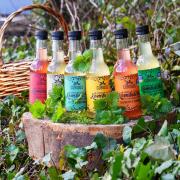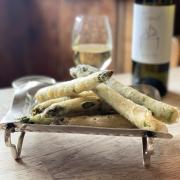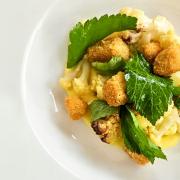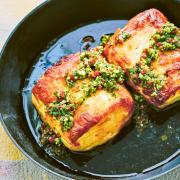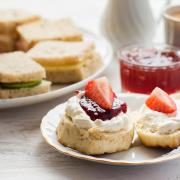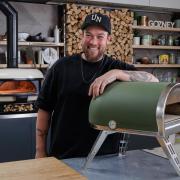It feels somehow appropriate to meet social media influencer, Julius Roberts, nicknamed the ‘goat man’ by me and my friends, on Zoom. Julius is a figure who, for the 473k of us who follow him on Instagram, warms our screens with snapshots of daily life at his West Dorset smallholding. It’s a page my friends and I return to when - having all moved to the city – we are pining for the countryside. We share his recipes of poached rhubarb with cardamom or fresh-caught sea bass with ‘punchy aioli’; and, for a moment, we’re back in deepest Dorset.
One may be forgiven for thinking that, given the way Julius captures the beauty of the county, Dorset has always been his home. Farms, fields and animals are not, however, what he grew up with. A Londoner, born and bred, what is perhaps most surprising about Julius was his decision, aged 23, to leave the bright city lights in order to raise goats and grow tomatoes.

Fresh out of university, where he studied sculpture, Julius found his way into Soho’s Noble Rot, a restaurant intent on cooking ‘quality ingredients’ simply. Working 18-hour shifts, he quickly realised that restaurant life wasn’t for him. ‘I was living off coffee and spending my day stressed to the core in a windowless kitchen,’ he tells me. Julius was much more curious about the ‘twinkly-eyed growers’ who would appear each morning with crates of glistening produce fresh from their farms, fields and market gardens. And so, he hatched a plan to grow his own food and ‘reconnect with the natural world’.
The decision to swap swanky city life for mud and muck first took him to his parents’ cottage in Suffolk. His aim was to turn their home into a smallholding. Yet, with the ground too frozen to plant and the news that most chickens don’t lay eggs in winter, those first few months weren’t filling him with self-sufficiency confidence. Intent to give it a proper shot, however, he bought some pigs. And those pigs changed everything.

Seven years and 150 sheep later, Julius is now settled in West Dorset, as he felt the city was encroaching on Suffolk. ‘When we first moved in, the meadows were up to our ears and buzzing with butterflies,’ he smiles. ‘Watching my goats come out of the trailer with the expansive view of the vale behind them made me feel at home… it was magical.’
Magical experiences are always close by for Julius. He waxes lyrically about the joy of picking apples on a mellow autumn day or tucking into a hearty bowl of sausage stew eaten ‘by the fire with rain lashing against the windows.’
His new cookbook, The Farm Table reflects this idyllic rural existence, it is filled with lush descriptions of pastoral life - he poetically observes how ‘winter melts away into the honeyed haze of summer’ - as well as extolling the delights of recipes he has created such as his ‘go-to sauce’ anchovy crema with crisp radishes on toast for breakfast.

As we talk about his life as a cook, farmer and gardener, I wonder about the difficulties he may have experienced in balancing the rosy and romantic with some of the harsher realities of farm life. Does he ever feel a disconnect between his online and his real life? After a hesitation he reflects on how addictive Instagram can be. ‘I must limit time on the app to make sure that I’m out there,’ he gestures towards the outdoors bathed in September sunshine, which I can see behind him, ‘living and being present. Then it’s okay.’
However, I’m still curious if the constant need to curate his life continues to affect him even when he is ‘out there.’ He admits that for him, the world of Instagram can be a judgmental one, and how the worry of what people are going to say ‘can keep you more inclined to post the rosy stuff.
‘Take yesterday’s story as an example.’ A post in which he detailed the horrors of flystrike (maggots eating the skin of sheep). ‘Often, I wouldn’t post that kind of story because I’d be worried about showing the use of chemicals to treat it. But I was glad to post it because that’s the truth, and I think people want to see the harder moments.’

The more Julius talks about his online world, the more I come to understand how important sharing his highs and lows with his followers on Instagram has been for him in making the leap from the city to rural Dorset. ‘In the beginning I was on my own, having just moved here with my dog. Instagram was like having a companion in a way,’ he reflects. ‘It gave me a reason to do what I was doing.’
Now, with nearly half a million followers, I’m surprised it still feels ‘personal and intimate’ to him; but through social media he’s found both ‘community’ and drive. While people may be following @juliusroberts for cute content of baby goats or the odd GQ Style feature, it has also attracted a younger audience. ‘I think that people have been so interested because I’m a young person making this leap. It’s a scary thing to do,’ he adds. ‘I’ve also noticed how some people really care about their food, how it’s grown and why that matters.’
It’s perhaps not surprising that, in these years of record temperatures, floods and storms, young people are seeking out other ways to live and be in harmony with the world. When I ask Julius how he, and the wider farming community are reacting to the climate crisis, he tells me that it’s a big part of why he does what he does.

The Farm Table promotes, above all else, the importance of seasonality, a theme that runs through the book which is divided into the four seasons. ‘Why would you fly asparagus from Peru when it grows so well in England?’ he questions. Passionate about the need for us all to eat less meat and respect the lives of animals, Julius shares this belief by doing, not just by saying. ‘There’s a lot of preaching in this world, people have strong opinions and say them loudly. I just hope that the joy I take in my lessons be my message.’
As we talk about farming’s impact on our environment it quickly becomes apparent that the farm table is a complicated one to sit at. Offline, Julius does not shy away from what he feels needs to change industry-wide, reflecting on how a lot of farmers probably see him as an ‘anti-voice’. Although as our discussion develops, being pro or anti seems too simplistic a stance. Amidst inflation, rising food prices, farm related suicides, Brexit, biodiversity loss, government trade deals, pesticides, supermarkets and debt, farming is an industry as complex as it is important.
So, I am fascinated to hear that Julius makes more money from the new schemes that work to protect nature - such as the Sustainable Farming Incentive - than from his sheep. ‘If you treat your field to make room for biodiversity, you get paid a lot for it,’ says Julius, who is quietly confident about the future of regenerative farming. ‘My hope,’ he says by way of conclusion, ‘is that farmers can get both the respect and money they deserve, and that nature doesn’t have to be squeezed out in the process.’

For if Julius’s new book and his wider work is about anything, it’s nature: its flavours, beauty and surprises. Flicking through his recipes with their mouth-watering photographs it’s easy to see how both his time working at Noble Rot, and his journey into the Dorset countryside have inspired his dishes. His food is simple, locally sourced and makes you want to stick a fork through the page. The question isn’t what to cook, but what to cook first: his epic tarragon roast chicken 'one of life’s great pleasures’, or a pear and walnut upside down cake which ‘sings with warm flavours from the spices’? Although the deep green pasta, with its ‘revitalising Popeye hits of green’ promises to be ‘wonderfully nourishing’ in winter.
I slip one last question in before our Zoom session concludes: if Dorset were a dish, what dish would it be? ‘If I went fishing tonight, I’d take a loaf of bread in my bag, and a few tomatoes from the polytunnel. I’d catch some mackerel, cook them up on the beach and have them with grated tomato on toast - pan con tomate. That would feel seasonally appropriate.’ He hesitates: ‘That’s a Spanish dish though, so it’s not very Dorset is it?’
His answer perfectly captures some of the complexities we’ve discussed regarding the farm table. How to be global yet local; nature-led yet profitable; romantic yet realistic? Such as with Julius Robert’s life on his Dorset farm, it’s all a process of constant and delicious learning for this first-generation farmer and chef.
Follow on Instagram @juliusroberts

Hearty sausage stew with beans, Swiss chard & cinnamon
This is a dish I often find myself yearning for on a long, dark evening. It sits somewhere between a soup and a stew. As the beans cook, they relax into the unctuous broth, studded with rosemary, chilli and cinnamon for a soothing warmth. If you can find Italian sausages, they have a coarser texture and pleasing richness, but a quality British banger will do the trick too. We eat this on our knees by the fire with rain lashing against the windows. All it needs is a hunk of bread with butter thick enough to leave teeth marks.
Serves 4–5
500g Italian sausages
3 cloves of garlic
2 celery sticks
2 brown onions
3 tbsp olive oil
a generous pinch of chilli flakes, for warmth
a few sprigs of rosemary (sage or thyme also work)
2 bay leaves
1 stick of cinnamon
a small glass of Madeira, sweetish sherry, beer or white wine
2 plum tomatoes from a tin
1 x 700g jar of white beans (or 2 x 400g tins – I use 1 cannellini and 1 butter bean)
750ml chicken stock
250g Swiss chard or cavolo nero
Method: Start by slicing the skin of the sausages so you can remove the meat. Then roughly break into small meatball size pieces. Finely slice the garlic, celery and onions. Get a large heavy-based pan hot, drizzle in the olive oil and, once warm, add the sausage. Fry for a few minutes to release the fat and get some colour on the meat. Turn the heat right down and add the garlic, chilli flakes, rosemary, bay leaves and cinnamon. Don’t let the garlic take on any colour – this stage is about slowly infusing flavour into the oil, so you want a low heat and a gentle sizzle.
When ready, pour in the Madeira to deglaze the pan – you can do this early, to cool down the pan if your garlic is beginning to colour. With a wooden spoon, scrape up all the goodness from the bottom of the pan, then add the onions and celery, and crush in the tomatoes. Season generously, mix well and cook on a gentle heat for 10–12 minutes, until the onions are sweet and wonderfully softened. Add the beans and pour in the stock. Bring to a gentle simmer, then cook for about 20–30 minutes, until the broth thickens and the flavours come together. Strip the stalks from the Swiss chard and chop into 2cm pieces. Add them to the broth and simmer for a few minutes, then add the leaves and stir through. Put the lid on, turn off the heat and leave for 5 minutes. When ready, remove the lid and have a taste. You might want to add a touch more chilli flakes if the warmth isn’t quite there, and more salt if the broth isn’t rich enough. Pour into large bowls and serve with thick slices of lavishly buttered bread for dunking.

Epic Tarragon Roast Chicken
There are recipes in this book that I love because they are interesting, there are those that I love for their simplicity, and there are those that I find myself making again and again. This is the latter, a great roast chicken, the heart of home cooking and one of life’s great pleasures. I relish the ritual, my family’s fight over the wings, the secret chef ’s treats of the oysters, the leftover sandwiches and bubbling stocks. There is no meal that makes me feel more at home. In my mind, there are three keys to a good roast chicken . . . juicy meat, brown salty skin and most importantly a ton of sauce. And it’s the sauce of this chicken that really sets it apart: handfuls of tarragon, lashings of cream and a proper dollop of mustard, which when combined with the cooking juices, garlic and wine creates a truly epic mouthful.
Serves 5
1 organic chicken
3 tbsp olive oil
1 whole head of garlic
250ml quality double cream
a 20g bunch of fresh tarragon, stalks removed, roughly chopped
1 large heaped tbsp Dijon mustard
a glass of dry white wine
Method: Start by spatchcocking the chicken. To do this, turn it over and cut along one side of the spine from the tail to the neck. Then turn it over, open out the two sides and press down hard to flatten it. Your butcher will gladly do this for you if you prefer. Lay the chicken in a large, high-sided roasting tray, season generously with salt on both sides and leave for an hour at room temperature so it loses the chill of the fridge.
Preheat your oven to 220°C fan/240°C/ Gas Mark 7. When ready, generously drizzle the skin with olive oil and work it into all the nooks and crannies. Smash the head of garlic and hide the cloves underneath the chicken, then roast in the oven for 20–30 minutes, until the skin begins to turn golden brown. Meanwhile, mix the cream, tarragon and mustard in a bowl and season well with salt and pepper. After 20–30 minutes, turn the oven down to 140°C fan/140°C/gas mark 3, take out the chicken and pour a generous glass of white wine into the tray. Then pour the tarragon cream all over the chicken and place back in the oven for 30–40 minutes until it’s ready. To judge when it’s cooked, I check the deepest part of the thigh with a temperature probe, looking for 65–70°C. If you don’t have one, prod this point with a skewer and ensure the juices run clear. At this point, remove from the oven and leave the chicken to rest for 15 minutes, covered loosely with a bit of foil. Carve straight into the tray and serve as you like, with lots of the sauce, garlic and a zingy green salad.

Pear and Walnut Upside Down Cake
I love a good cake, and this is just that. Juicy, moist and wonderfully light, it sings with warm flavours from the spices, while the walnuts provide an earthy and satisfying crunch. The pears are first cooked in a caramel until sweet and tender, and you then pour the batter over and bake the cake upside down. Once cooked, turn out the cake and let the caramel trickle into the sponge below. All it needs is a spoon of crème fraîche and you will be happy as can be. This cake lasts a good few days, especially if you keep it covered. Gently warm any leftover slices in a low oven before you tuck in, which brings it back to life.
makes 8 slices
For the pear topping
6 ripe pears, peeled, quartered and cored
50g butter
80g soft brown sugar
juice of 1½ lemons
For the cake
200g butter, softened
200g caster sugar
4 eggs
seeds from 5 cardamom pods
3 cloves
100g walnuts
200g self-raising flour
4 tsp baking powder
5g sea salt
1 tsp ground cinnamon
100g sour cream
For serving
crème fraîche or double cream
Method: Place a wide frying pan on a medium heat and add the butter. When it begins to melt, add the pears, cut side down, sprinkle the soft brown sugar over the top and shimmy the pan, using the weight of the pears to mix the sugar into the butter. Squeeze in the lemon juice and cook for 8–10 minutes, until the pears have softened and the butter and sugar have become an amber-coloured caramel. Remove the pears and arrange cut side up, fat side out in a 9-inch cake tin (you may not need all of them). Don’t use a springform tin, as the small gap allows the caramel to trickle out. But if you have to, use some baking parchment to create a seal (if possible, you want the cake touching the metal sides as this creates a lovely crust). Leave the caramel bubbling on a low heat until it is properly thick, then pour over the pears. Preheat your oven to 180°C fan/ 200°C/has mark 4.
For the cake, you can either mix with an electric whisk or use a stand mixer. Place the softened butter in a large bowl and add the sugar. Whisk until the butter is pale and fluffy, scraping down the sides a few times to make sure it is evenly incorporated. With the mixer running, add the eggs one at a time, making sure each one is thoroughly mixed before adding the next, or the butter may split.
Grind the cardamom seeds and cloves in a pestle and mortar, then pour into a bowl. Bash the walnuts in the pestle and mortar or crush them in a folded tea towel, using a rolling pin. You want to keep a chunky texture. Mix the flour with the baking powder to ensure it is evenly distributed. Sift, then add to the butter with the salt, cinnamon, ground spices and walnuts. Mix these dry ingredients into the batter, then stir through the sour cream. Pour the cake batter over the pears and lightly even out the top.
Now, remembering that all ovens are different, place in the middle of your oven for up to an hour, until the cake is set. After around 30 minutes, I turn the heat down to 160°C fan/180°C/ gas mark 4 to make sure the top doesn’t get too dark. Keep an eye, but don’t open the door or you risk the cake deflating. After about 50 minutes, give the cake a jiggle – if the middle is at all wobbly it’s not quite cooked. To test, insert a skewer into the middle, when it comes out clean it’s ready.
At this point, remove from the oven and leave to sit for 15 minutes, then place a chopping board gently on top of the cake. Flip the cake and board, then remove the tin and you should have a beautifully risen cake with juicy caramelised pears on top. Serve it warm, with crème fraîche or double cream and a coffee.
All recipes taken from The Farm Table by Julius Roberts (Ebury Press, £27)
Photography by Elena Heatherwick











